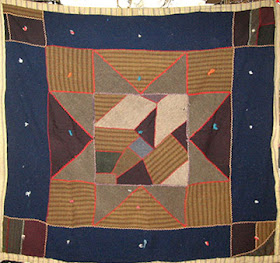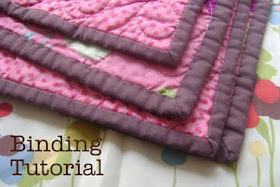Binding about 1860
We bind our quilts today quite differently than in the past.
The biggest difference may be that they used a single layer of narrow, straight-grain binding, while most of us use a double layer of wider binding.
Recent quilt from
Diary of a Quilter blog
You can find many How-to's on quilt binding that will tell you exactly how to get the current look, which is often the final contrasting frame for a quilt.
Quilt Dated 1855
Quilters in the past used contrasting binding but they were also fond of binding that disappeared---white binding on a white border.
Those of us looking to determine a date for a quilt are glad of the differences, as wider binding helps us date antique tops that have been quilted later.
A mitered corner in a recent quilt
Becky taught a workshop in binding corners recently---how to get this sharp, square mitered look that is a necessity today. And she asked me if they did this in the past. I told her I'd throw a study on it. I had noticed that a lot of antique quilts are bound with a curve at the corner.
I remember that in the 1970s when the church ladies would quilt my old tops (for $30) they'd often cut the corners round. It's a tradition that's been forgotten, I think.
They tuck and turn that straight-grain binding around the curve.
And stretch a little. Here's a mid-19th century binding with an inserted cording.
Another corded, rounded corner
This would, of course, been neater with a bias-cut binding rather than straight-grain.
But you really don't see a lot of bias binding until the 20th century, when the bias-tape manufacturers began advising quilters to use it. But I didn't find any pictures of mitered corners.
I did find this which I think is a corner cut off and bound separately---the binding strip does not really go around the corner; the quilt is bound with four strips, which is the way I learned to do it by looking at old quilts.
When did quilters start using mitered corners?
While I was looking through pictures Becky went through her old quilts and found this one.
"This gorgeous Broken Star sorta has a mitered corner. It definitely has the mitered fold on the front and the back uses a gathered technique."
"Narrow bias binding with pieces joined at a 45 degree angle. 3 corners are mitered and 1 was done with a squared off fold. Very interesting."
"I'm not sure when these kits were produced, but it was made by Eva Strait, Wamego, Kansas and given to my Aunt and Uncle at the time of their wedding in 1941. Eva was the groom's grandmother. It was never used and still has faint pencil lines. My aunt gave it to me in the late 1980's and I'm it's current keeper which is fun...," she writes.
So Becky's antique is an example from the late 1930s-early '40s with a sorta miter.
I guess we are going to have to look closer to find out more. The 1852 quilt above with the shaped edge looks to be straight grain pulled and tucked around the angles.
































































